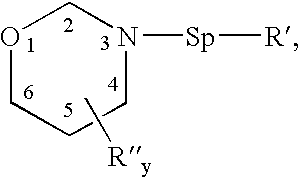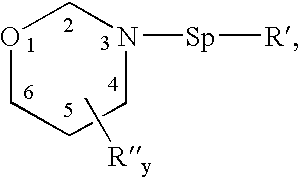Benzoxazines, thermosetting resins comprised thereof, and methods for use thereof
a thermosetting resin and benzoxazine technology, applied in the field ofbenzoxazine, can solve the problems of increasing processing conditions for adhesive interfaces within electronic components, new challenges for reliable assembly of microelectronic components, and moisture entrapment within the void volume, and achieves increased adhesion at interfaces, low shrinkage on cure, and easy cure
- Summary
- Abstract
- Description
- Claims
- Application Information
AI Technical Summary
Benefits of technology
Problems solved by technology
Method used
Image
Examples
example 1
[0102]Benzoxazine 1. Hydroquinone (8.23 grams, 75 mmole), 3-amino-1-propanol vinyl ether (15.1 grams, 150 mmole), and toluene (100 mL) were placed in a 250 mL round bottom flask. Paraformaldehyde (9.0 grams, equivalent to 300 mmole of formaldehyde) was then added to the flask. The flask was then equipped with a magnetic stir bar, a Dean-Stark trap, and condenser. The mixture was stirred and heated to reflux under an argon blanket. A total of 5.2 milliliters (96% of theory) of water was collected in the trap after two hours reflux. The reaction mixture had turned black by this point. The toluene reaction solution was washed with two 50 mL aliquots of 5% aqueous sodium hydroxide, followed by one 50 mL aliquot of water. The toluene solution was passed over a bed of neutral alumina and then evaporated to yield 3.8 grams (14% of theory) of a viscous, light brown liquid.
example 2
[0103]Benzoxazine 2. Hydroquinone (8.23 g, 75 mmol), allylamine (8.57 g, 150 mmol) and toluene (100 mL) were placed in a 250 mL flask. Paraformaldehyde (9.0 grams, equivalent to 300 mmole formaldehyde) was added along with a magnetic stir bar. The flask was equipped as described in Example 1 and brought to reflux. The full theoretical amount of water was collected within forty-five minutes of reflux. The toluene solution was washed with six 25 ml portions of 5% aqueous sodium hydroxide, and three 30 ml aliquots of water. The toluene solution was then dried over anhydrous magnesium sulfate and then passed over 26 grams of activated, neutral alumina. The toluene was removed to yield 11.0 grams (54% of theory) of a red, semi-solid material.
example 3
[0104]Benzoxazine 3. A 500 mL flask was equipped with a magnetic stirring bar and a Dean-Stark trap. This assembly was then charged with hydroquinone (33.0 g, 300 mmole), 1-amino-2-propanol (45.0 g, 600 mmole), and about 38 g (1260 mmol) of paraformaldehyde. Approximately 300 mL of toluene was added to the flask and the mixture was heated to reflux. As the reaction proceeded all of the reactants dissolved and a homogeneous solution formed. After one hour of reflux at 110° C., about 22 mL of water was collected in the Dean-Stark trap. The solution was allowed to cool to room temperature before proceeding to the next step. At this point a bis-benzoxazine intermediate with two pendent alcohol groups should have formed in the reaction vessel. No attempt was made to isolate the intermediate, instead this diol was converted to a diacrylate. The solution was placed in an ice bath at 0° C., along with 100 g (1 mole) of triethylamine. The acrylation was achieved by the dropwise addition of a...
PUM
| Property | Measurement | Unit |
|---|---|---|
| Temperature | aaaaa | aaaaa |
| Temperature | aaaaa | aaaaa |
| Fraction | aaaaa | aaaaa |
Abstract
Description
Claims
Application Information
 Login to View More
Login to View More - R&D
- Intellectual Property
- Life Sciences
- Materials
- Tech Scout
- Unparalleled Data Quality
- Higher Quality Content
- 60% Fewer Hallucinations
Browse by: Latest US Patents, China's latest patents, Technical Efficacy Thesaurus, Application Domain, Technology Topic, Popular Technical Reports.
© 2025 PatSnap. All rights reserved.Legal|Privacy policy|Modern Slavery Act Transparency Statement|Sitemap|About US| Contact US: help@patsnap.com



